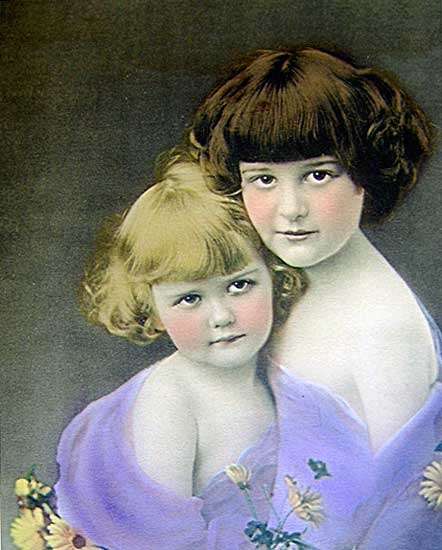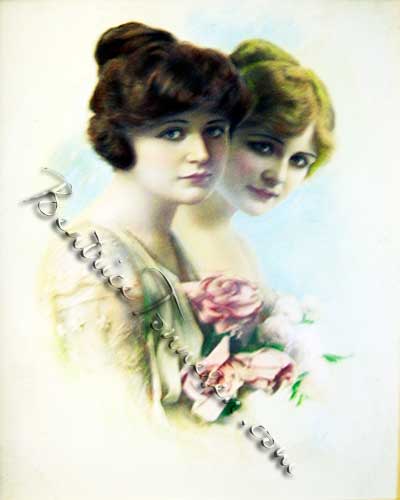 This pastel and watercolor original from a photo by Beatrice Tonnesen was found in the archives of the old Thomas D. Murphy Calendar Company. Traces of the photo underlying the painting can be seen upon close examination. Although it is not known who added the pastel and watercolor elements, the photographic element clearly originated with Beatrice Tonnesen. The dress worn by the dark-haired model is one that was worn by a different model in a photo in the Tonnesen archive of the Oshkosh Public Museum. Based on the dating of other photos featuring these same models, I would place this one at around 1918. I have two other pieces of original illustration art in my collection which I believe to have originated with Tonnesen photos. However, this is the only one I've ever been able to verify.
This pastel and watercolor original from a photo by Beatrice Tonnesen was found in the archives of the old Thomas D. Murphy Calendar Company. Traces of the photo underlying the painting can be seen upon close examination. Although it is not known who added the pastel and watercolor elements, the photographic element clearly originated with Beatrice Tonnesen. The dress worn by the dark-haired model is one that was worn by a different model in a photo in the Tonnesen archive of the Oshkosh Public Museum. Based on the dating of other photos featuring these same models, I would place this one at around 1918. I have two other pieces of original illustration art in my collection which I believe to have originated with Tonnesen photos. However, this is the only one I've ever been able to verify.
It is known that the publishing companies purchased photos from Tonnesen and other photographers and then, sometimes, had their own staff illustrators add color, detail and/or backgrounds. It is also known that the photographic studios employed staff artists who sometimes embellished their photographs before selling them to the publishing companies. In Tonnesen's case, we know that both she and her sister Clara sometimes acted as illustrator. With no signature on the painting, however, the identity of the illustrator remains a mystery.
This painting measures approximately 19 X 25 (without mat and frame). Presumably, the Murphy Company published it as a print, although I have never come across one.
All Content Copyright 2009 Lois Emerson
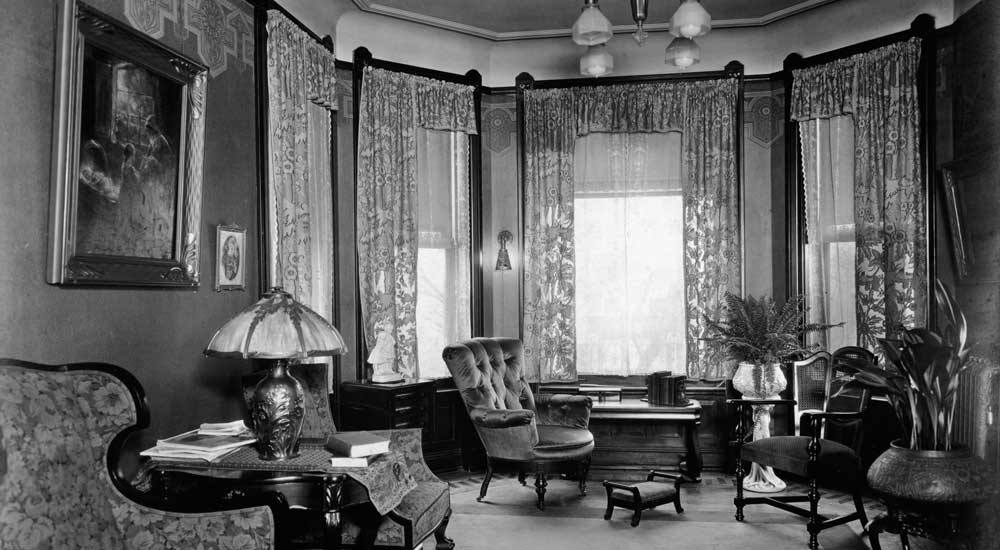

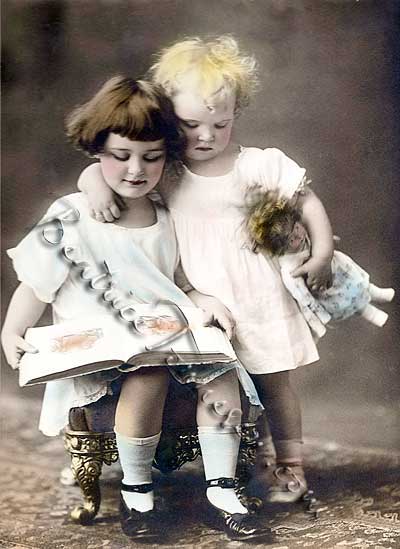 The blond toddler shown in Tonnesen photos and prints circa 1917-20 has been identified as Jane Berghauer (1916-1994). She had earlier been identified by fellow models as Janie Burkhardt or Janie Berkhauer. Searching on close matches, I found that the Chicago Tribune reported on November 3, 1917 that Jane Berghauer had placed second in a “prettiest baby” contest for 1-2 year olds.
The blond toddler shown in Tonnesen photos and prints circa 1917-20 has been identified as Jane Berghauer (1916-1994). She had earlier been identified by fellow models as Janie Burkhardt or Janie Berkhauer. Searching on close matches, I found that the Chicago Tribune reported on November 3, 1917 that Jane Berghauer had placed second in a “prettiest baby” contest for 1-2 year olds.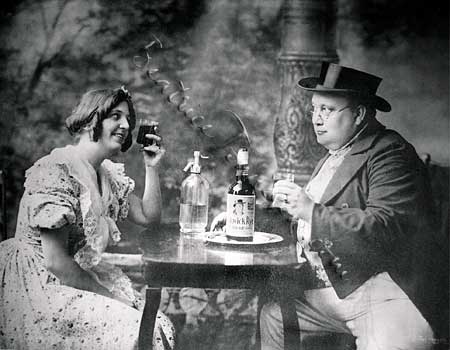 Before the Tonnesen Sisters became known for their art prints, they were known for their pioneering work in advertising.
Before the Tonnesen Sisters became known for their art prints, they were known for their pioneering work in advertising.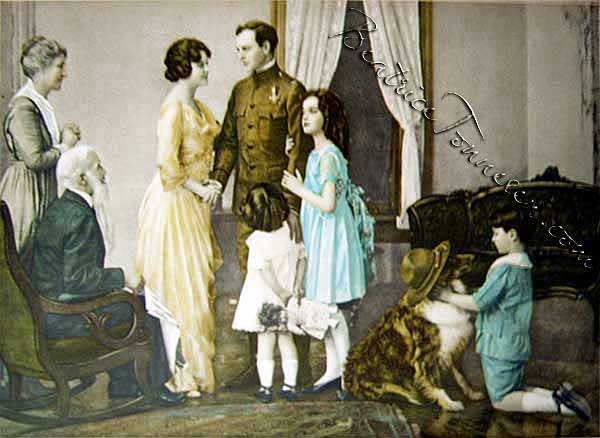 This amazing World War I- themed photo contains seven Tonnesen models, as well as the distinctive-looking collie often seen in Tonnesen's work. During WWI (1914-18), scenes of families welcoming their loved ones home or seeing them off to war were extremely popular.
This amazing World War I- themed photo contains seven Tonnesen models, as well as the distinctive-looking collie often seen in Tonnesen's work. During WWI (1914-18), scenes of families welcoming their loved ones home or seeing them off to war were extremely popular.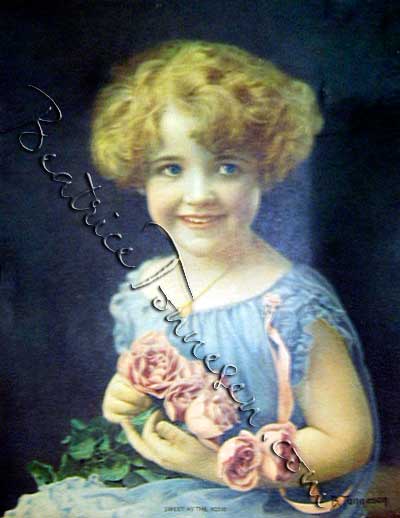 Two of the prints that appear in our slideshow are signed “Tonneson”, as opposed to the usual “Tonnesen.” These are “Miss Coquette” (Image 3, Album 1) and “Roses” (Image 13, Album 2). Both prints feature the same curly-haired little girl. Both are machine-signed.
Two of the prints that appear in our slideshow are signed “Tonneson”, as opposed to the usual “Tonnesen.” These are “Miss Coquette” (Image 3, Album 1) and “Roses” (Image 13, Album 2). Both prints feature the same curly-haired little girl. Both are machine-signed.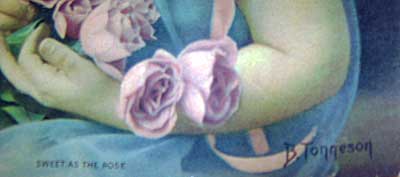 And why does this odd spelling of Tonnesen's name always appear on prints featuring this same little girl? I'm wondering if the little girl was Fox's daughter. He had two daughters who would have been the right age. Hazel, born in 1920, and Flo, born in 1919. Photos of the daughters as adults appear in R. Atkinson Fox His Life & Work, by Rita C. Mortenson on pages 14 and 17. Call me crazy, but… Flo's curly hair – curled down onto her forehead – her twinkling eyes and smile, and her defined cheekbones all look like Miss Coquette to me! If you have the book, it might be fun to check it out.
And why does this odd spelling of Tonnesen's name always appear on prints featuring this same little girl? I'm wondering if the little girl was Fox's daughter. He had two daughters who would have been the right age. Hazel, born in 1920, and Flo, born in 1919. Photos of the daughters as adults appear in R. Atkinson Fox His Life & Work, by Rita C. Mortenson on pages 14 and 17. Call me crazy, but… Flo's curly hair – curled down onto her forehead – her twinkling eyes and smile, and her defined cheekbones all look like Miss Coquette to me! If you have the book, it might be fun to check it out. (The image of Fox's signature shown here is taken from page 97 of Collector's Value Guide to Early Twentieth Century American Prints by Michael Ivankovich. Collector Books, Paducah, Kentucky: 1998. Used with permission.)
(The image of Fox's signature shown here is taken from page 97 of Collector's Value Guide to Early Twentieth Century American Prints by Michael Ivankovich. Collector Books, Paducah, Kentucky: 1998. Used with permission.)